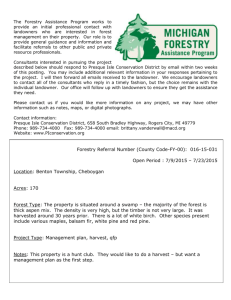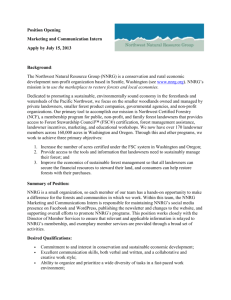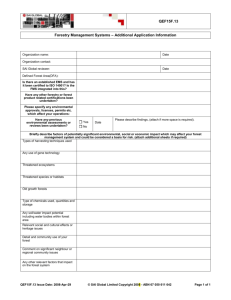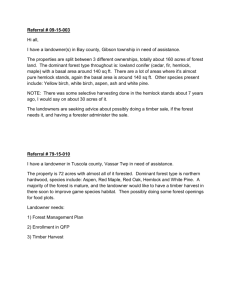4/18/2011 – WON Conference – Kalamazoo, MI – Kellogg Biological
advertisement
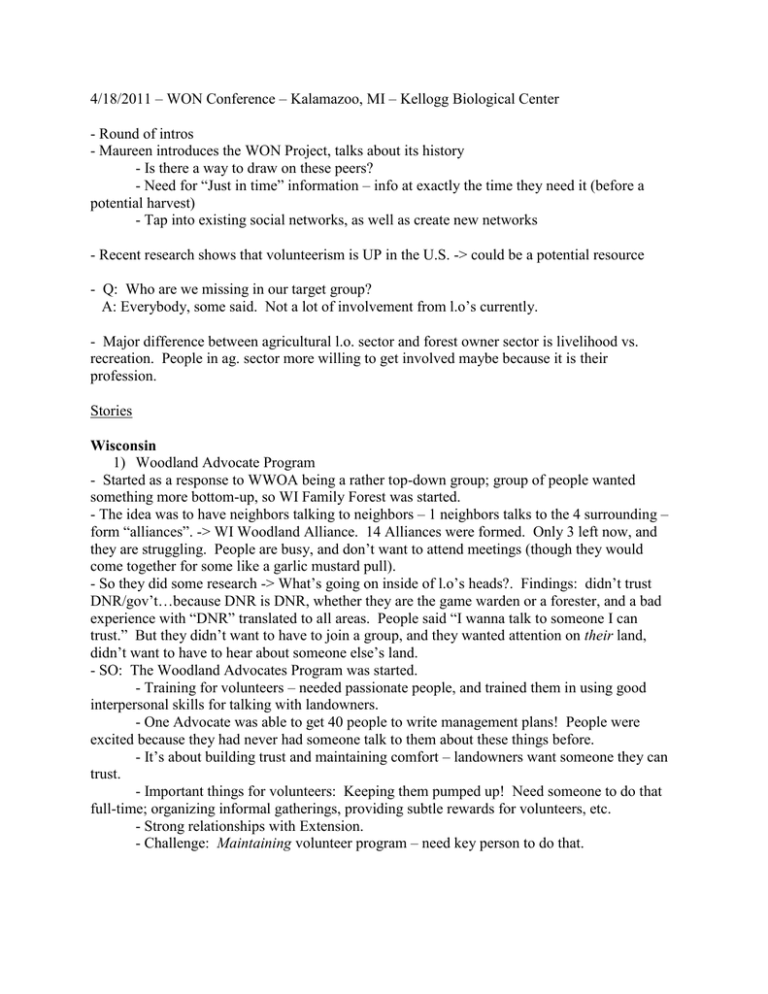
4/18/2011 – WON Conference – Kalamazoo, MI – Kellogg Biological Center - Round of intros - Maureen introduces the WON Project, talks about its history - Is there a way to draw on these peers? - Need for “Just in time” information – info at exactly the time they need it (before a potential harvest) - Tap into existing social networks, as well as create new networks - Recent research shows that volunteerism is UP in the U.S. -> could be a potential resource - Q: Who are we missing in our target group? A: Everybody, some said. Not a lot of involvement from l.o’s currently. - Major difference between agricultural l.o. sector and forest owner sector is livelihood vs. recreation. People in ag. sector more willing to get involved maybe because it is their profession. Stories Wisconsin 1) Woodland Advocate Program - Started as a response to WWOA being a rather top-down group; group of people wanted something more bottom-up, so WI Family Forest was started. - The idea was to have neighbors talking to neighbors – 1 neighbors talks to the 4 surrounding – form “alliances”. -> WI Woodland Alliance. 14 Alliances were formed. Only 3 left now, and they are struggling. People are busy, and don’t want to attend meetings (though they would come together for some like a garlic mustard pull). - So they did some research -> What’s going on inside of l.o’s heads?. Findings: didn’t trust DNR/gov’t…because DNR is DNR, whether they are the game warden or a forester, and a bad experience with “DNR” translated to all areas. People said “I wanna talk to someone I can trust.” But they didn’t want to have to join a group, and they wanted attention on their land, didn’t want to have to hear about someone else’s land. - SO: The Woodland Advocates Program was started. - Training for volunteers – needed passionate people, and trained them in using good interpersonal skills for talking with landowners. - One Advocate was able to get 40 people to write management plans! People were excited because they had never had someone talk to them about these things before. - It’s about building trust and maintaining comfort – landowners want someone they can trust. - Important things for volunteers: Keeping them pumped up! Need someone to do that full-time; organizing informal gatherings, providing subtle rewards for volunteers, etc. - Strong relationships with Extension. - Challenge: Maintaining volunteer program – need key person to do that. - Gerry Mich comment: No need to try to make l.o’s into professionals, let them be landowners. Woodland Advocates is about just being a neighbor. Not trying to make them “mentors” to “enlighten” people…just provide support. - It costs about $1000 to train an Advocate and pay for their mileage for visits to l.o’s. Training involves how to interview/listen. Also trained in different available programs so that they are aware of the resources available to the landowners they talk to. - Phase 2: Was going to be a follow-up to the l.o.’s that were helped by an Advocate, to see what was implemented. But they ran out of funding for now. This follow-up is needed though – don’t want to be a one-time door knocker. Success: Someone they can trust, builds comfort; reached people that had never been talked to before about woods; donations 2) Aldo Leopold Foundation – a coalition of organizations - NGO started by Aldo’s kids. Partnered with WFF and various agencies - Pieces: lots of l.o’s who have done nothing on their land; 26,000 l.o’s in WI with >10 acres; 20% have MFL plans. - In SW WI, there are lots of groups, but they aren’t knitted together! How to join efforts? - Turn mailing list into database to follow-up with workshop attendees and look at progress over time. Think of l.o’s as “clients.” Use data base for peer network. - The project coordinator can act as a liaison ->important! -The peer (who helps another peer) needs a toolbox to tap into – pro they can trust - Peer can help “broker relationship” with the DNR – built TRUST. - “Their people skills are probably more valuable than what they know about trees” - landowner _-> peer -> forester …building trust, longterm relationship with peer, peer can fill capacity if/when DNR can’t - How do we measure intermediate successes (benchmarks) in a management plan? - Science and communication – Randy Olson, “Don’t Be Such a Scientist” 3) National Network of Forest Practitioners - Works with other organizations, e.g. Living Forest Coop – service coop, part of tool box, local forest employed (trust), collective marketing, peer support/education Need to build workforce Network of established organizations/agencies Emphasis on diverse audiences Minnesota 4) MN Forest Association - 1870’s -> one of oldest conservation associations - Trying to decide whether they are “big tent” or “little tent” in terms of who should join. Leaning toward little tent…those involved are landowners “and friends” (DNR, etc.) -Can talk about which pro’s are the good ones (agencies and Extension don’t have that ability) -Can focus on individual landowners (newsletter spotlights, etc.) -“Call Before You Cut” – 6 states already doing it – MFA to be lead organization - Can be a network that is there where you need it, “just in time” info Challenges: Who are these 75,000 woodland owners? Also, the scope of the problem Successes: Contacting sustainable forest law enrollees 5) MN Women’s Woodland Network - balance gender participation -> 6 local networks -woman learn differently -> more informal, “kitchen table talks” and just discussing things - example of what women wanted to learn: chainsaw course (so they had one) Challenges: webpage needed – how to communicate? - How to connect with network? - Local women Indiana 6) Indiana Woodland Owners Assn - Walnut Council - very social-oriented group, but professionals involved too - they learn from each other during downtime - peer networking -> people getting better - website -> people use it (even though it is a really old format) - 200,000 l.o’s in IN, mostly small parcels. 3.8/4.4 mil woodland acres = private - Ties to the Land – positive l.o. response -Forest “Blitz” – they did a bunch of household visits, peer and pro involved, to spread the word - Made brochures for realtors – “What every new woodland owner should know” - Education committee (from IN DNR) made survey tool to evaluate different state organizations, find out what landowners are doing, get them involved in state-wide program ->central site for events -cooperative weed mgt areas – monitoring and awareness Michigan 7) Michigan Forest Assn - primarily forest owners and professionals and some others - projects: free for Stewardship plans - Ties to the Land - Teacher workshops in forestry - Annual mtg – social and educational - Newsletter – talks about invasives - Developing listing of attornies and accountants regarding forest estate planning, and recommended forestry professionals - 2 tax programs in MI - Regional landowner network - NIPF coalition – collective of organizations and agencies - Projects: Legislative forestry day 8) Michigan Assn of Conservation Districts - forestry owners are just one of their audiences (wide reach) - forestry assistance in some areas - NRCS partnerships and MDARD - Getting them to understand value of mgt first, then making connection with professional (logger, private forester, etc….private sector) - “peer advocates” 9) MI DARD - partner with other agencies to serve forest owners - new focus on rural development 10) MI TNC - NIPF strategy - took the Indiana strategy of “Forest Bank” - interviewed landowners - looking for incentives for Forest Bank involvement in MI - Partner with NRCS (WHIP and EQIP) - regional project - Pigeon River Habitat Initiative -> focus on private landowner outreach -p2p is more agency to agency in this case, but could be beneficial to involve landowner to help relay the info -Fire Learning Network – landowner common issues -> objectives 10) Extension - Master programs - miforestpathways.net Various challenges mentioned throughout stories: - Getting people to trust peer networks (credibility), how do we build that? Maintaining membership People don’t want to be involved in more groups $$ Reward volunteers/support system Showing results long-term (in short-term funding systems - Aging popn of l.o’s Length of tenure Hard to measure follow up to mgt plans “people skills” Benchmarks of success Pairing science and communication! Demonstrate return on investment Building a workforce Expand msg beyond landowners Identifying who these landowners are Scope! Industry – paused CBYC program Large # of ‘unengaged’ forest landowners (mysterious – don’t know much about them) – overwhelming task for pro’s ID propositions that capture attn Timely follow-up Non-resident forest ownership Database mgt Keep feedback evals simple How does tech capacity balance with p2p strategies? Technical capacity challenged by increased responsibilities Perceived conflict with private sector Landowner distrust to actual mgt commitment Bureaucratic procedures to enroll in assistance Fragmented landscapes Priority Session: Voted for top 4 challenges and broke into groups. My group discussed the large number of disparate groups doing similar things, and how to unite them. - Is there one organization that can step up? (like Landcare in Aus) - Advertising to other groups - Leaders of other groups meeting annually Words people used to describe how they felt after the meeting: Exciting, revolutionary, inspired, more passionate, invigorated, energized, hopeful, concerned (need to continue to move forward on all this and make something happen), good start, opening doors Hi all, I wasn’t able to answer all of your questions during the Q&A period, so I thought I would address the ones that I missed here. Please feel free to post any further questions and I will do my best to answer those as well! ~Amanda Were these peer to peer events you analyzed simply talks with "hang time" afterwards or were these other types of activities? The groups had many different types of gatherings. Some examples include: general meetings, where they discussed general business, current events, projects that the group was working on, etc. (some groups had monthly meetings, others had an Annual Meeting); courses or workshops; guest speakers; volunteer work days; field days/property tours, which were often held on group member properties. Some members also gathered informally for labor parties on each other’s lands. For the most part, across all cases, these gatherings seemed to be pretty informal and there was time for socializing (usually with food :)) before/during/after events. Hi Amanda – Did you detect any interesting similarities or differences between your US examples and the Land Care example from Australia? - Jim Johnson Thanks for your question, Jim. I was actually amazed at some of the similarities I saw between my U.S. and Australia cases, considering how diverse they were. U.S. woodland owners and Australian graziers alike desired locally/personally relevant information, wanted to take care of their land, and voiced the prevalence of independent personalities and some degree of mistrust toward government/professionals amongst themselves or their respective landowning communities in general. The groups had similarly informal feels and provided opportunities to socialize (though this last aspect seemed especially true of the Aussie groups, maybe it’s cultural :)). The biggest difference between the U.S. and Aus. groups was the focus: the Aus Landcare groups were battling land degradation and restoration issues, whereas the U.S. Landcare group and the other U.S. groups faced fewer environmental challenges (though both countries wrestled with their own invasive species!) and were more focused on preserving forest and agricultural ways of life and preventing loss to development, and generating landowner involvement in management. I was talking to Steve Swenson about the similarities of the case study themes after the presentation, and he summed it up well: “People are human all over the world.” I guess so! Shorna also mentioned during her presentations that the NY group was interested in asking: What are the implications of this research for family forest outreach? In the interest of time, I deleted a couple slides that discussed the practical applications from this research, drawn from the findings, for those who have the opportunity to work with forest landowner networks. A few examples of these considerations include: • Hold regular group functions – Whether in the field or in the classroom/meeting hall, these events build group community and provide a forum for landowners to get together. • • • Take coffee breaks – Or tea breaks, like the Australians :). Participants appreciated informal opportunities to socialize, and also used these time periods for impromptu peer exchange. Go beyond education – The groups were well-rounded in what they offered members. Social and emotional incentives (meeting new friends, barbeques, volunteering opportunities, sense of group ownership, etc.) provided further reason for involvement, beyond getting information. Network, network, network! – Relationships with government agencies, universities, private professionals, and other landowner/community groups increased the resources available through the groups. More tips and further detail will be available soon in a document that I’m working on now. Stayed tuned to this Ning site for further info!
